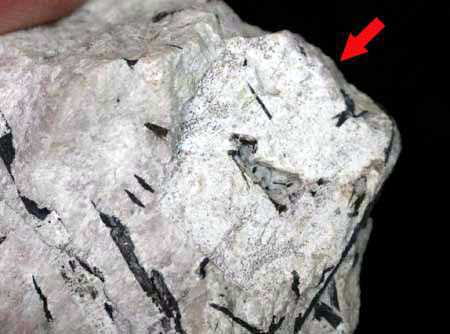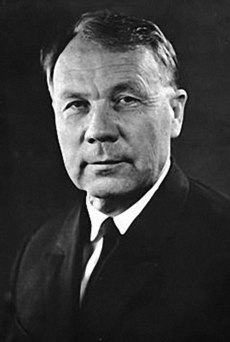Gerasimovskite
A valid IMA mineral species - grandfathered
This page is currently not sponsored. Click here to sponsor this page.
About Gerasimovskite
Formula:
(Mn,Ca)(Nb,Ti)5O12 · 9H2O
Colour:
brown to gray or light gray
Lustre:
Pearly
Hardness:
2
Specific Gravity:
2.52 - 2.58
Crystal System:
Amorphous
Name:
Named in 1957 by Evgeny Ivanovich Semenov in honor of Vasilii Ivanovich Gerasimovsky (Василий Иванович Герасимовский) (20 June 1907, village of Artemyevskaya, Vologda province - 11 August 1979, Transbaikalia) in 1934, discovered (together with O.A. Vorobyova) industrial deposits of loparite ore on the Kola Peninsula.
This page provides mineralogical data about Gerasimovskite.
Unique Identifiers
Mindat ID:
1678
Long-form identifier:
mindat:1:1:1678:6
GUID
(UUID V4):
(UUID V4):
743a44d5-0e98-45aa-926e-55c8cd683f64
IMA Classification of Gerasimovskite
Approved, 'Grandfathered' (first described prior to 1959)
IMA Formula:
Mn2+(Ti,Nb)5O12 · 9H2O (?)
First published:
1957
Classification of Gerasimovskite
4.FM.25
4 : OXIDES (Hydroxides, V[5,6] vanadates, arsenites, antimonites, bismuthites, sulfites, selenites, tellurites, iodates)
F : Hydroxides (without V or U)
M : Hydroxides with H2O +- (OH); unclassified
4 : OXIDES (Hydroxides, V[5,6] vanadates, arsenites, antimonites, bismuthites, sulfites, selenites, tellurites, iodates)
F : Hydroxides (without V or U)
M : Hydroxides with H2O +- (OH); unclassified
8.7.8.3
8 : MULTIPLE OXIDES CONTAINING NIOBIUM,TANTALUM OR TITANIUM
7 : Miscellaneous
8 : MULTIPLE OXIDES CONTAINING NIOBIUM,TANTALUM OR TITANIUM
7 : Miscellaneous
18.1.37
18 : Niobates and Tantalates
1 : Niobates and tantalates containing neither rare earths nor U
18 : Niobates and Tantalates
1 : Niobates and tantalates containing neither rare earths nor U
Mineral Symbols
As of 2021 there are now IMA–CNMNC approved mineral symbols (abbreviations) for each mineral species, useful for tables and diagrams.
| Symbol | Source | Reference |
|---|---|---|
| Gms | IMA–CNMNC | Warr, L.N. (2021). IMA–CNMNC approved mineral symbols. Mineralogical Magazine, 85(3), 291-320. doi:10.1180/mgm.2021.43 |
Physical Properties of Gerasimovskite
Pearly
Colour:
brown to gray or light gray
Hardness:
2 on Mohs scale
Cleavage:
Perfect
In one direction
In one direction
Density:
2.52 - 2.58 g/cm3 (Measured)
Optical Data of Gerasimovskite
Type:
Biaxial (-)
RI values:
nα = 1.740 nβ = 1.810 nγ = 1.810
2V:
Measured: 18°
Max Birefringence:
δ = 0.070

Image shows birefringence interference colour range (at 30µm thickness)
and does not take into account mineral colouration.
and does not take into account mineral colouration.
Surface Relief:
Very High
Dispersion:
r > v moderate
Optical Extinction:
Parallel extinction, elongation positive.
Chemistry of Gerasimovskite
Mindat Formula:
(Mn,Ca)(Nb,Ti)5O12 · 9H2O
Crystallography of Gerasimovskite
Crystal System:
Amorphous
Comment:
diffuse lines at 2.60, 1.85, and 1.64 A.
X-Ray Powder Diffraction
Powder Diffraction Data:
| d-spacing | Intensity |
|---|---|
| 1.89 Å | (100) |
| 3.70 Å | (80) |
| 3.18 Å | (60) |
| 2.10 Å | (40) |
| 1.64 Å | (20) |
Comments:
Lovozero massif, Russia. Data collected after heating the sample at 900°C.
Geological Environment
Paragenetic Mode(s):
| Paragenetic Mode | Earliest Age (Ga) |
|---|---|
| Stage 4b: Highly evolved igneous rocks | >3.0 |
| 35 : Ultra-alkali and agpaitic igneous rocks |
Type Occurrence of Gerasimovskite
General Appearance of Type Material:
Platy masses up to 1.5x1x0.3 cm.
Geological Setting of Type Material:
In ussingite-bearing pegmatites. Thought to have formed by the hydrothermal alteration of minerals of the murmanite-lomonosovite series.
Reference:
Semenov, E.I. (1957) Oxides and hydroxides of titanium and niobium in the Lovozero alkalic massif. Institute of Mineralogy, Geochemistry, Crystal Chemistry and Trace Elements, Akademiya Nauk CCCP, Trudy: 1: 41-59.
Synonyms of Gerasimovskite
Other Language Names for Gerasimovskite
Relationship of Gerasimovskite to other Species
Forms a series with:
Common Associates
Associated Minerals Based on Photo Data:
| 4 photos of Gerasimovskite associated with Ussingite | Na2AlSi3O8OH |
| 3 photos of Gerasimovskite associated with Aegirine | NaFe3+Si2O6 |
| 2 photos of Gerasimovskite associated with Birnessite | (Na,Ca)0.5(Mn4+,Mn3+)2O4 · 1.5H2O |
| 1 photo of Gerasimovskite associated with Pectolite | NaCa2Si3O8(OH) |
| 1 photo of Gerasimovskite associated with Manganonordite-(Ce) | Na3SrCeMn2+Si6O17 |
| 1 photo of Gerasimovskite associated with Albite | Na(AlSi3O8) |
Related Minerals - Strunz-mindat Grouping
| 4.FM. | Charleshatchettite | CaNb4O10(OH)2 · 8H2O |
| 4.FM. | Dinilawiite | [Pb4O2Al(OH)5]2(S2O3)2 · H2(S2O3)(H2O)5 |
| 4.FM. | Yttrotungstite-(Nd) | NdW2O7(OH) · H2O |
| 4.FM.15 | Franconite | Na(Nb2O5)(OH) · 3H2O |
| 4.FM.15 | Hochelagaite | (Ca,Na,Sr)(Nb,Ti,Si,Al)4O11 · 8H2O |
| 4.FM.15 | Ternovite | (Mg,Ca)Nb4O11 · nH2O |
| 4.FM.25 | Belyankinite | Ca1-2(Ti,Nb)5O12 · 9H2O (?) |
| 4.FM.25 | Manganbelyankinite | (Mn,Ca)(Ti,Nb)5O12 · 9H2O |
| 4.FM.30 | Silhydrite | Si3O6 · H2O |
| 4.FM.35 | Cuzticite | Fe3+2(TeO6) · 3H2O |
| 4.FM.50 | Qatranaite | CaZn2(OH)6(H2O)2 |
| 4.FM.55 | Hydroplumbite | 3PbO · H2O |
Other Information
Health Risks:
No information on health risks for this material has been entered into the database. You should always treat mineral specimens with care.
Internet Links for Gerasimovskite
mindat.org URL:
https://www.mindat.org/min-1678.html
Please feel free to link to this page.
Please feel free to link to this page.
Search Engines:
External Links:
Mineral Dealers:
References for Gerasimovskite
Reference List:
Localities for Gerasimovskite
Locality List
 - This locality has map coordinates listed.
- This locality has map coordinates listed.
 - This locality has estimated coordinates.
ⓘ - Click for references and further information on this occurrence.
? - Indicates mineral may be doubtful at this locality.
- This locality has estimated coordinates.
ⓘ - Click for references and further information on this occurrence.
? - Indicates mineral may be doubtful at this locality.
 - Good crystals or important locality for species.
- Good crystals or important locality for species.
 - World class for species or very significant.
(TL) - Type Locality for a valid mineral species.
(FRL) - First Recorded Locality for everything else (eg varieties).
- World class for species or very significant.
(TL) - Type Locality for a valid mineral species.
(FRL) - First Recorded Locality for everything else (eg varieties).
All localities listed without proper references should be considered as questionable.
Greenland | |
| [Mineralogical Record - Vol 24 No 2] +1 other reference |
Russia | |
| ... |
| Pekov (1998) |
| Pekov (2000) |
| Arzamastsev et al. (2008) | |
| Pekov (2000) | |
| Pekov (1998) |
| Trud.Inst.min.geokh.cryst. redkikh elementov (1957) +3 other references | |
| Pekov et al. (2013) | |
Quick NavTopAbout GerasimovskiteUnique IdentifiersIMA Classification Classification Mineral SymbolsPhysical Properties Optical Data Chemistry Crystallography X-Ray Powder DiffractionGeological EnvironmentType Occurrence SynonymsOther LanguagesRelationshipsCommon AssociatesStrunz-MindatOther InformationInternet Links References Localities Locality List




 symbol to view information about a locality.
The
symbol to view information about a locality.
The 



Pegmatite No. 60, Second Eastern Stream, Karnasurt Mountain, Lovozersky District, Murmansk Oblast, Russia